The Web We've (Never) Lost
Based on my talk for PragueJS meetup from February 2024
Posted on by Jan Vlnas
This text is partially a transcript, partially a recollection of a talk I presented on the PragueJS meetup in February 2024.[1]
Abstract:
Doesn't it feel like the web is getting worse every day? Do you miss the days when Google wasn't a garbage factory, Twitter wasn't a cesspool of Nazis, and you weren't treated like a pair of eyeballs with a wallet? Don't worry, the web of yore is still alive and kicking – in fact, it's thriving. You just need to know where to look. Let's take a dive into the non-mainstream web, where people create blogs and websites for the sheer joy of it, algorithmic feeds are nowhere to be found – and you can join, too!
The Web We’ve (Never) Lost[2]
I’m Jan and I work as an engineer with the API team at Mews. While I went through many roles in my career, they all have one thing in common: I’m always building something for the web.
I do like web. Not just like a development platform, but as a medium and as a cultural artifact. And in my talk, I want to show you why we should pay more attention to the web in its own right. Particularly this year.
Let me start with two questions:
- Do you have a social media profile? (on Twitter, Facebook, LinkedIn or Instagram) Majority of the attendees raised hands.
- Do you have a personal website, perhaps a blog? Only a few people raised hands.
Interesting, and we're on a JavaScript meetup where most of us build things for the web. So for those of you who didn't raise your hand for the second question I hope to give you some inspiration.
Over the last year there were a few though pieces in major publications about how internet isn’t fun anymore, how social media is dying. And look, that’s nothing new, in fact, that “Bring back GeoCities” is from 2015.
Still, there seems to be a shift in power dynamics on the web. Part of it is definitely a generational change, it’s now clear that generation Z uses the web differently than millennials.
And I don’t want to sound like Abe:
“These young’uns with their TikToks have no idea what the real web is about! Back in my days, when we wanted to surf the web, we had to walk 10 miles to the beach”
I want to instead focus on established platforms which became synonymous with social media and the web.
2022—2023
A few things happened in 2022 which we saw to fully play out last year.
First, let’s talk about Google. For the past few years it became quite a meme how Google Search is just full of ads and you really have to look for actual, organic results.

Screenshot via Dmitri Brereton's Google Search Is Dying
Clearly, we’ve come a long way from simple 10 blue links, since Google now pushes its additional properties.
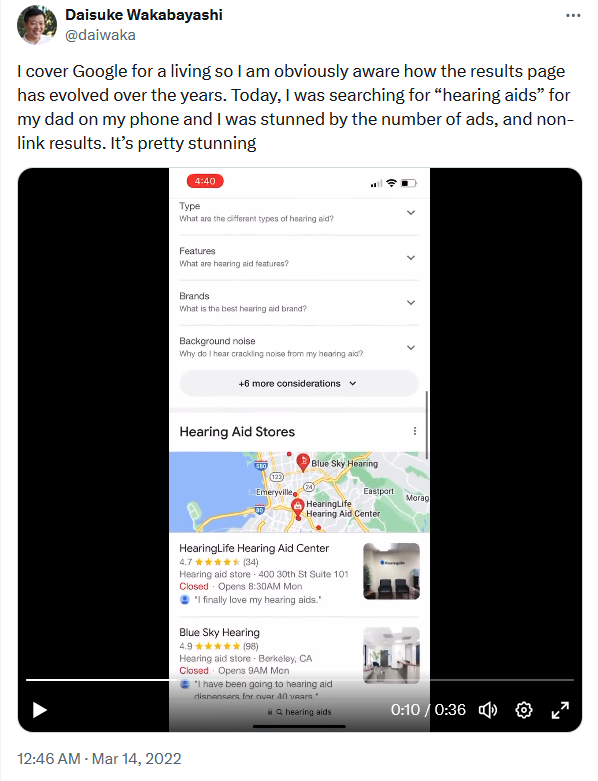
Well, we now have somewhat an objective research confirming our suspicion (PDF). Google is getting worse as it loses its fight against SEO spam. The only silver lining is that competitors are doing worse.

Photo from Politico: AI hearing leaves Washington with 3 big questions.
Now, let’s add that guy to the mix. For those that don’t know, Sam Altman is CEO of OpenAI. While GPT has been available for a while now, ChatGPT was released in fall of 2022 and to this day we’re still trying to grasp the consequences of widely available generative Large Language Models (LLMs).
Since LLMs are trained on data from the web, they’re really good at generating plausibly looking articles.

Growth hackers like this guy love ChatGPT. Generate thousands of articles based on the competitor’s website structure? No problem.
So how does Google deals with AI-generated content?

Not well.

Anyway, let’s talk about this guy. Note the text on the card he’s holding. It’s not a coincidence.
Musk reluctantly bought Twitter in 2022 (but he really tried not to). I’m not going to talk about his misdeeds, how Twitter became a prime source of disinformation and conspiration theories – many of them spread by Musk himself.
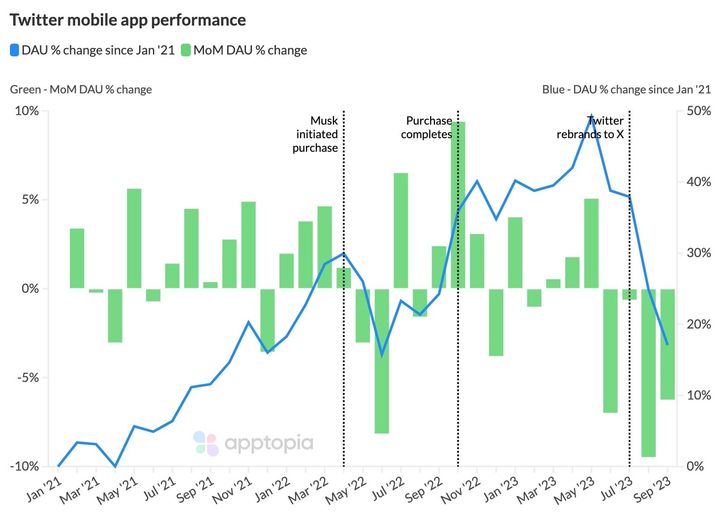
Source: The Elon Effect
Sure, Twitter is losing users, but probably not so quickly as some of us hoped. Personally I turned my profile private and I try to minimize interaction with the platform to a minimum. I just don’t want to take part in billionaire’s mid-life crisis toy.
What’s more important though, Twitter is losing a lot of money from advertising, which is its major source of income. $2.5 billion is about half of what they made previous year. I bet we’ll see more desperate moves to monetize existing users. And there is an underlying theme to this all.
Enshittification
Have you heard about enshittification? Only a handful of people raised their hand.
It was named the word of year 2023.
Enshittification is a term coined by Cory Doctorow to explain the dynamics of online platforms:
Here is how platforms die: first, they are good to their users; then they abuse their users to make things better for their business customers; finally, they abuse those business customers to claw back all the value for themselves. Then, they die.
We see this playing out with Amazon, TikTok, Reddit, but also with Uber and AirBnB.[3] But the prime example is Facebook.

Matthew Inman, aka The Oatmeal captured the phenomenon of enshittification before it even had name.
Circa 15 years ago, Facebook was a hip place where following friends and pages was convenient. But once we’ve got accustomed to the algorithmic newsfeed, Facebook started to push more advertising on us – and also pushed content producers to pay for ads. It’s sort of inevitable trajectory of platforms which act as an intermediary between the users and businesses, because they control both sides.
And we see the enshittification cycle to start anew, with many Twitter users moving to Threads by Meta. I don’t see where this could go wrong.
Can we break the enshittification cycle? Are we doomed to move from one platform to another, always becoming a hostage in some grand enshittification scheme? Or is there something else?
Well, here’s a proposal. Instead of posting on yet another social media… We can build a website.
Where have all the websites gone?
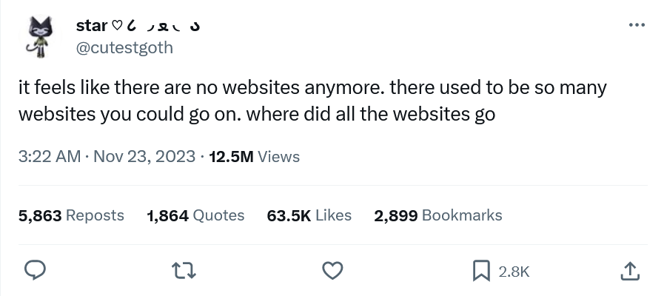
But after spending years in apps and on social media which actively discourage us from posting and clicking on links, one can get easily lost. I mean, it feels like the web became much smaller.
But the websites are still there – if you know where to look for them.
I particularly like this definition by (now defunct) community Yesterweb which defined the “core web” and the “peripheral web”:
The core web is the ‘default’ internet experience for all human beings, largely defined by monopoly-capitalist platforms like Facebook, Twitter, TikTok, Reddit, and others. […]
The peripheral web can be described as the outskirts of the core web, with platforms such as Mastodon, SpaceHey, Neocities, Discord and IRC chatrooms, Matrix rooms, various imageboards, and others, including various functional clones of core web applications. It is the digital countryside of the corporate megalopolis. […]
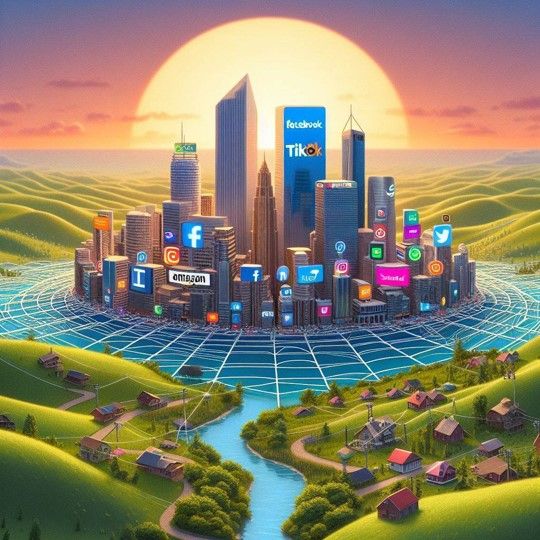
“[The peripheral web] is the digital countryside of the corporate megalopolis.” (generated with DALL·E 3)
But beside “peripheral web” there are different names for this idea, like:
Each of these names covers a bit different concept, but they have some things in common: they aim to create a web which is human-scale, sustainable, and devoid of corporate greed.
Maybe you’re thinking that it sounds great – but where do I start on this peripheral web?
Discovery
Search engines
First we have alternative search engines. And I don’t mean alternative as Bing or DuckDuckGo (which is mostly rebranded Bing). These are search engines with their own indexes and features which let you find content outside of big, Google-optimized sites.
Engines such as:
- Stract, an open-source engine which lets you filter results through so called Optics
- Wiby, a sort of “retro” search engine with a wonderful Surprise me! feature
- Marginalia, a DIY search engine with some very interesting and opinionated result filters
- Feedle which indexes data from RSS feeds, so mostly from blogs[4]
- Kagi, a paid search engine which aims to beat Google by being actually better
And there are many more interesting search engines.
Webrings
If you haven’t heard of webrings, they can look, for example, like this.

Banner from Geekring.
When you add your site to a webring, you will put links to the previous and next site in the ring, so visitors can find websites – maybe with similar focus, maybe not. Topics of those topics, varies from general like “personal websites”, through specific topics like digital accessibility, to very specific niches like french-speaking sites about salads. And again, there are many more webrings to browse.
Directories
Before search engines became the de facto method of navigating the web, we had directories. Yahoo started that way, Czech search engine Seznam (“the list”) started that way, even Google used to have a directory of its own. Directories still exist and there are some new takes on it.
For example, there’s Curlie which builds on the legacy of DMOZ. Some newer contenders include Ooh.directory focused on blogs, and Personalsit.es focused on personal websites.
Communities
While social media became synonymous with Facebook and few other, large, ad-driven platforms, there are still many, many smaller on-line communities focusing on various niches.
One of the original, truly web-native communities, were GeoCities, a free hosting which was home to websites for various niches. Since 2009 we can only experience GeoCities in its archived form, but Neocities picked up the torch.
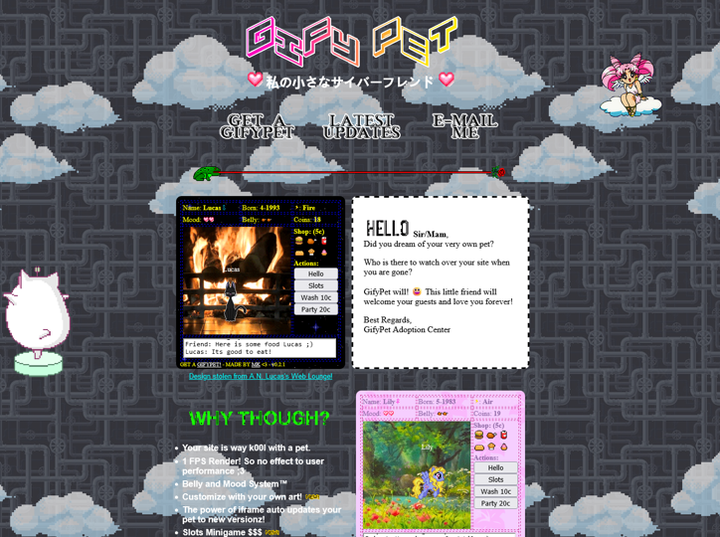
GifyPets, one of the featured Neocities site. It lets you build your own pet you can put on your site and other visitors can interact with it.
For more advanced users there is Glitch, “the friendly place where everyone builds the web”. Beside static websites it also supports Node.js. While it’s similar to Replit or CodeSandbox, Glitch focuses on community and creative aspects of coding. For example, Stefan Bohacek hosts hist social media bots on Glitch. You can go straight to the editor, “remix” the project and create a bot of your own.
Maybe you heard about MySpace, or even experienced it. Unlike today’s social media, MySpace allowed users to fully customize their profiles using custom CSS and HTML. This feature, which was originally a bug, lead to the notorious busy, tasteless user profiles with autoplaying music. While you may sneer at MySpace today, keep in mind that it raised a whole generation of web developers – many people were exposed to programming thanks to MySpace’s fortunate bug. And it’s where SpaceHey aims to be MySpace’s successor, a “retro social network” which allows users to fully modify their profiles.
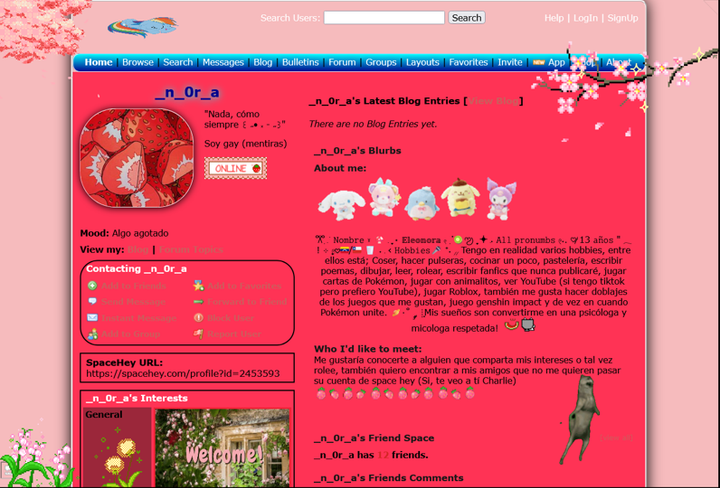
Example of profile customization on SpaceHey (check it out to fully appreciate the animations and custom cursor).
Speaking of social media and the peripheral web, I must mention the Fediverse. There’s Mastodon as a non-profit, decentralized microblogging platform, but that’s just the tip of the iceberg. There’s a multitude of server software and instances running that software, all with different features and different communities, but all still able to talk to each other. I will just point you to a few resources: fediverse.info with a basic explanation, Fediverse Observer and to the Fediverse to view different instances, and Fediverse Party to check out various federating applications.
What can I do?
Okay, so no you have plenty of resources you to discover this world wild web, but what you can do with it? Let me break it down into three categories: read, curate, and created.
Read
I love the recommendation to just click around and find out[5]:
If you care about the indie web growing, by all means write, by all means create, by all means curate. But most of all, just read. Or listen, or experience. Spend an afternoon clicking around, like everybody used to. The more people who do that, the more everything else will slot into place without even having to think much about it.
And when you are clicking around, you may as well read. And if you stumble upon someone’s blog and you enjoy their writing, you may as well add their blog to an RSS reader, so you can check if they write something in the future.
What’s that, RSS feeds? Yeah, the technology which was pronounced dead (mostly thanks to demise of Google Reader) is very much alive. Let’s see, how many of you are using an RSS reader? Only a few hands raised. And how many of you listen to podcasts? Majority of people raised hands. So you are using RSS feeds as well.
The technology faded into the background, becoming the reliable plumbing of the web. RSS readers let you be mindful about the content you consume and don’t trap you into an endless scrolling just to show you more ads.
Good place to start with RSS feeds is About Feeds.
Curate
While you’re reading interesting content, you may as well collect it and share it with others. You don’t need anything fancy, a simple list you post somewhere will suffice. For example, back in 2013 I noticed that people are putting various lists of resources on GitHub, so I naturally created a list of such lists; it’s just a single Markdown file and occasionally I still add something new there.
If you prefer something more social or simpler for maintenance, there’s for example Are.na, which lets you curate images and text into various channels. Yes, it’s sort of like Pinterest but without crap.
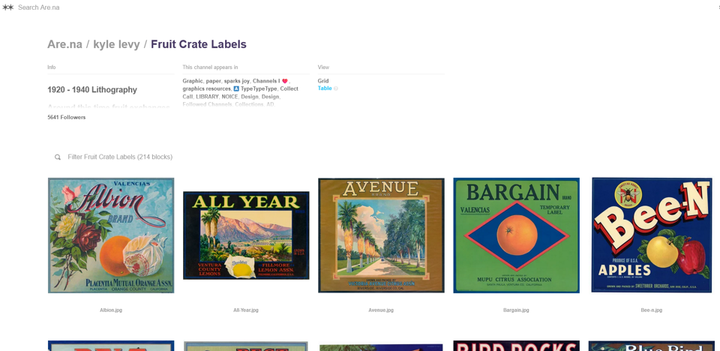
One of my favorite Are.na channels is the collection of fruit crate labels.
Create
Perhaps you now have an itch to create something on the web yourself.
Make yourself a homepage which shows your personality, or at least contact details. It can be complex and playful as nuel’s, or extremely simple and boring as mine.
Create a single-serving site. Just to give you a few examples:
- This one asks Is it Friday yet?
- This one makes everything OK
- Czechs and Slovaks probably know Miluji práci (I love my job); it’s actually very NSFW soundboard
Last year I also made a single-serving site of my own to track whether Twitter’s API is free. It didn’t become a viral sensation but it was fun to build. I let the domain expire, but the page is archived on GitHub.
If you want to start or return to blogging, I particularly like the advice to treat a blog as a brain dump. If you don’t feel like buying a domain (just yet), there are many blogging platforms for there – but hold on, before you sign up on Substack, check out some of these:
- Write.as is a hosted version of open-source project WriteFreely which can also bring your blog to the fediverse
- Micro.blog despite its name is also good for “macro” blogging; while it’s paid, it has also community features and federates with the Fediverse
- Bear Blog is my favorite for its plain looks and straightforwardness
- Prose is a blog hosting service which belongs under pico, a collection of services using SSH (so you
scpyour blog to the server)
For more options, check out list of blogging platforms from Jason Velazquez.
And if you decide to (re)start blogging, Jason Kottke has a message for you:
Oh you’re blogging again? Cute. WELCOME BACK MOTHERFUCKERS.
—Tweet from Jason Kottke, August 29, 2014
Wrap up
I want to end with quote from Tim Berners-Lee:
What is made of the Web is up to us. You, me, and everyone else. […]
Let’s use the web to create neat new exciting things.
Let’s use the Web to help people understand each other.
So, here’s what I want you to do:
- Click around and find out.
- Start curating stuff into a list.
- Create your homepage.
Let’s create some new, exciting things on the web, for the web.
Resources
Discovery
Search Engines
Directories
Webrings
- Webring List
- a11y webring club
- Hotline Webring (no longer accepting new sites)
- TheOldNet WebRing
- CSS Joy
- Geekring
Communities
What can I do?
Read
- Click around, find out
- RSS feeds
Curate
Create
- Single-serving sites
- Blogs
- Get blogging!
- Start a fucking blog (contains strong language)
- Jason’s list of blogging platforms
Additional reading
- Motherfucking website (contains strong language)
- Where have all the websites gone? by Jason Velazquez
- Where have all the flowers gone? by Dave Rupert (reply to Jason’s post)
- The Internet Is About to Get Weird Again by Anil Dash
- Why the Internet Isn’t Fun Anymore by Kyle Chayka
- The Web Is Fucked (contains strong language)
Indie web, Small web et al.
- Yesterweb
- IndieWeb
- Small web
- What is the Small Web? by Aral Balkan
- The small web is beautiful by Ben Hoyt
- Rediscovering the Small Web by Parimal Satyal
- web0 manifesto
- smol web
- what is the smol web? by Eric Bower
- smolweb
- slow web
- SmolNet
Footnotes
There's also a recording if you really want, but it's, ummm, not very good. It’s definitely not my best performance. ↩︎
The title is not-so-subtle reference to Anil Dash's classic article from 2012 The Web We Lost. ↩︎
Wikipedia helpfully provides more examples. ↩︎
Remember Technorati? ↩︎
Yeah, it’s a reference to “FAFO” – but without negative consequences. ↩︎


